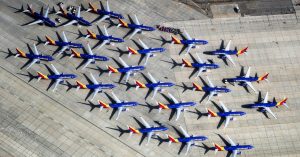
Erik Simonsen/Getty Images
In the nearly five months since the Federal Aviation Administration grounded Boeing’s 737 MAX, investigators have revealed a series of issues with the jet’s software and raised questions about how the planemaker and the regulator allowed it to take off in the first place. The timeline for returning the MAX to passenger service remains murky, but that doesn’t mean it can’t fly at all. Monday morning, a Boeing-owned 737 MAX 7 took off from King County International Airport-Boeing Field near Seattle, climbing to 24,000 feet as it headed west to the Pacific Ocean, then due south. Over the next few minutes, according to tracking service FlightRadar24, the plane shed altitude and speed, until it was flying at about 13,000 feet and a lazy 250 mph, about 50 miles off the Oregon coast.
Alex Davies covers autonomous vehicles and other transportation machines for WIRED.
For the next two hours, the MAX slowed as it climbed, then sped up as it dropped, cycling between the two more than a dozen times. Its altitude fluctuated between 10,000 and 14,000 feet, its speed between 150 and 300 mph. All the while, it stayed in the same general area, far from normal air traffic, producing a flight path that resembled a pile of bent-out-of-shape paper clips. Then it climbed again, cruised back toward Seattle, and landed. (The FAA grounding order applied to MAX 8 and MAX 9 varieties of the jet; Boeing has yet to deliver any MAX 7s.)
Boeing’s test pilots traced a swirly route off the Oregon coast on a data-gathering flight in the 737 MAX 7.
FlightRadar24
This curious trip was a reconnaissance mission, but not to gather intel about anything on the ground. A Boeing spokesperson says it was an “engineering flight,” conducted at the FAA’s request, gathering data on the jet’s performance. The spokesperson offered no details on what sort of data Boeing was after, but it’s not surprising to see the test pilots imitating a yo-yo. The two MAX jet crashes—on Lion Air in October and Ethiopian Airlines in March, which together killed 346 people—happened just minutes into each flight, while the planes were climbing to their cruising altitude. The MCAS system, designed to automatically predict and prevent stalls by pointing the nose downward, kicked in when it shouldn’t have, plunging the planes toward the earth.
Whatever fix Boeing devises will have to address how MCAS works and interacts with related systems, ensuring that MCAS only activates when a stall is in fact imminent. Monday’s flight was likely a chance for the pilots to run through a series of potential failures. That means answering a lot of “what if” questions, says Pete Field, an aviation consultant and former Navy test pilot. “What if this part fails, how’s that going to affect it?” That lets Boeing’s engineers see how the plane’s software reacts to different types of bad information, from airspeed to temperature to altitude. The most important might be the plane’s angle of attack. That sensor appears to have malfunctioned on the Lion Air and Ethiopian flights, and had been a persistent problem for the MAX jet, CNN reported.
Field compares Monday’s flight to examining a witness in a courtroom: You only ask questions whose answers you already know. The maneuvers the Boeing pilots executed would have been tested in simulation first, to produce a good idea of what a real plane would do, and ensure no more lives were risked. If the plane had dropped more than expected, flying at about 10,000 feet would give the pilots ample time to recover, Field says.
Boeing CEO Dennis Muilenburg has said he expects that by the end of the year, the FAA will approve his company’s fix for the troubled jet, which involves a fundamental redesign of the software system, The Seattle Times reported. But before it can take off with passengers aboard, expect a few more up-and-down flights like this one.
More Great WIRED Stories
- How the West got China’s social credit system wrong
- The bizarre, peaty science of Arctic wildfires
- It Came From Something Awful blames 4chan for Trump
- Seeing through Silicon Valley’s shameless “disruption”
- The 20 most bike-friendly cities on the planet, ranked
- ✨ Optimize your home life with our Gear team’s best picks, from robot vacuums to affordable mattresses to smart speakers.
- ? Want more? Sign up for our daily newsletter and never miss our latest and greatest stories

